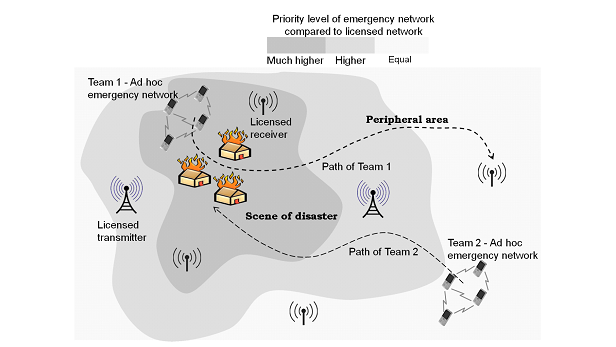Emergency Networking
Research | | Links:

The goal of this research project is to enable reliable and high data-rate wireless multimedia communication (e.g., images, voice, and live video streams) in licensed spectrum among first responders engaged in rescue and recovery missions in the aftermath of natural (e.g., earthquakes, hurricanes) and man-made disasters (e.g., terrorist attacks, industrial accidents). Traditional optimization-based approaches for resource management in wireless networks are not suitable for emergency networking in licensed spectrum due to the highly dynamic nature (non-stationarity) of the environment (due to its shared nature, unorganized and random data traffic, network attacks, and node mobility). While centralized approaches rely on unrealistic assumptions regarding knowledge of global network state, localized approaches fall short due to the inability of their constituent prediction models to capture the global network state based only on local information. To achieve the aforementioned goal, we envision a new paradigm of learning-based network management for emergency networking in licensed spectrum based on autonomic management principles. The objective of this research is to bestow the emergency network nodes with autonomic capabilities, i.e., self-configuration, for jointly determining the appropriate parameters for different communication functionalities through crosslayering; self-protection, for improving spectrum utilization and protection against intentional jamming through spectrum agility; and self-healing, for robustness under highly varying wireless channel conditions (due to node mobility and unorganized emergency network traffic) as well as under node (battery or hardware) failures.
This research project proposes a novel model-free Multi-Agent Reinforcement Learning (MARL)-based communication framework, for self-management of coordinating emergency network nodes. It also introduces the new notion of dynamic mission policies, which convey the priority of emergency network traffic compared to that of the incumbent networks’. This relative priority may vary over space (from the scene of disaster to the peripheral areas) and over time (from mission setup to rescue, recovery, and exit). Mission policy awareness helps steer the emergency network behavior based on Quality of Service (QoS) requirements of both emergency and incumbent networks without any cooperation from the latter. The project will focus on 1) designing the framework as well as addressing the challenges to the convergence of the proposed approach posed by the non-stationarity of the operating environment; 2) translating high-level dynamic mission policies into low-level communication requirements as well as incorporating this information into our framework; 3) assessing the performance of the framework in terms of convergence, policy conformance, and robustness through ns3 simulations and emulations (on ORBIT wireless network testbed at Rutgers University). Our research efforts will be driven by the extensive experience in emergency/disaster preparedness and response of public safety experts of the Rutgers Center for Government Services.
The proposed research represents a transformative shift from the established cross-layer optimization paradigm towards policy- and learning-based autonomic network resource management. This research project has a strong multidisciplinary component that involves a nexus of ideas from wireless communication, networking, algorithms, computer sciences, statistical learning, and distributed systems.

